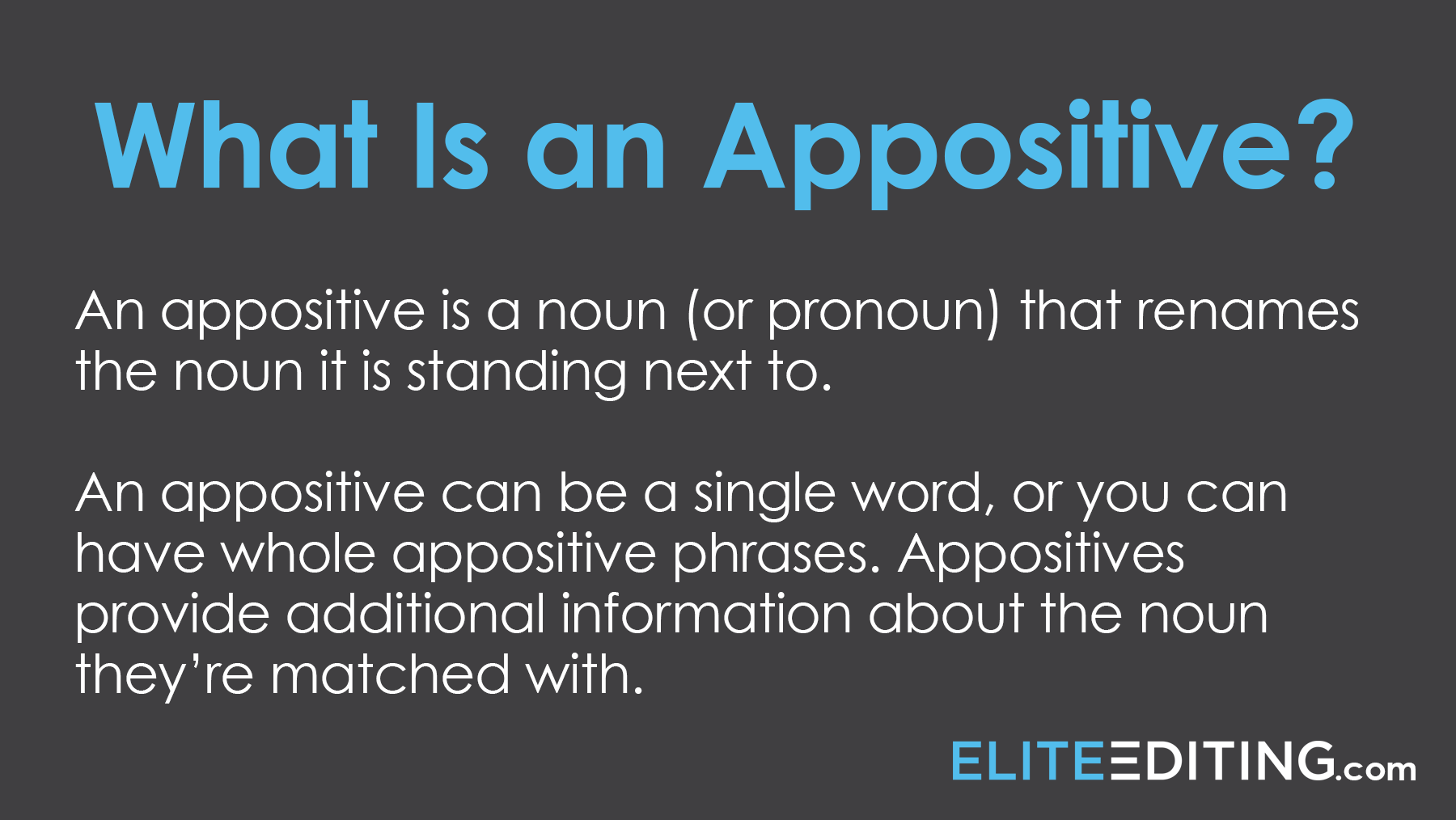
Sometimes it seem like grammar is full of stuffy, stodgy terms. What is a participle, for example? What the heck does antecedent mean? What’s an elliptical clause (yes, that’s a real thing)? It’s like you need to learn a whole other language just to learn English grammar.
Appositive is another one of those grammar-speak words. So what is an appositive? And how do you know if you’re using appositives correctly? Do appositives need commas? Can you also use parentheses or em dashes? And what’s all this about restrictive vs. nonrestrictive?
If you’re reading this, you’re about to find out exactly how to be positive you’re using appositives correctly. And we’ll sort out the most common issue—appositives and commas.
Appositives
Before we get to appositives and commas, let’s answer the original question: What is an appositive? The Merriam-Webster definition of appositive is “of, relating to, or standing in grammatical apposition.” The definition of apposition is “a grammatical construction in which two usually adjacent nouns having the same referent stand in the same syntactical relation to the rest of a sentence.” Well, that’s clear as mud.
Try to keep your eyes from rolling to the back of your head—here’s a simpler answer to the question, “What is an appositive?” An appositive is a noun (or pronoun) that renames the noun it is standing next to. An appositive can be a single word, or you can have whole appositive phrases. Appositives provide additional information about the noun they’re matched with.
Examples
My favorite national park, Yosemite, is great for camping.
I’ll read anything written by the author J. K. Rowling.
In the first example, “Yosemite” is an appositive for “my favorite national park”; in the second example, “J. K. Rowling” in an appositive for “the author.”
Restrictive vs. Nonrestrictive Appositives
You might have noticed that in the examples above, one appositive has commas around it while the other doesn’t. That’s because one appositive is nonrestrictive, and the other is restrictive. The way to figure out the whole restrictive vs. nonrestrictive appositive thing is to ask yourself whether the information provided by the appositive is nice…or necessary.
Nonrestrictive appositives are nice. They add information that might be useful, interesting, or helpful but that isn’t absolutely necessary to the meaning of the sentence. The first example above contains a nonrestrictive appositive, as the sentence still makes complete sense without the word “Yosemite.” While it’s nice to know that the speaker’s favorite national park is Yosemite, it’s not technically essential to one’s understanding of the sentence.
Restrictive appositives are necessary. The second example, “I’ll read anything written by the author,” barely makes sense because “the author” could be any writer. The sentence needs “J. K. Rowling” in apposition to make sense. Thus “J. K. Rowling” is a restrictive appositive.
Restrictive vs. nonrestrictive appositives get much easier with practice, so here are some more examples.
Examples of restrictive vs. nonrestrictive appositives
Restrictive: The poet Tracy K. Smith came to my local bookstore for a reading.
Nonrestrictive: Tracy K. Smith, the current poet laureate, came to my local bookstore for a reading.
In the first sentence, “Tracy K. Smith” is a restrictive appositive because it’s necessary information. “The poet came to my local bookstore for a reading” is vague and unhelpful—it’s not like there’s only one poet in the world. In the second example, “the current poet laureate” is a nonrestrictive appositive because it’s supplemental information. The sentence “Tracy K. Smith came to my local bookstore for a reading” makes perfect sense; “the current poet laureate” is there to provide some nice (but not necessary) additional information.
Those commas can also give readers important information about the appositives.
Restrictive: George’s cousin Ellen went to Italy with her son Max.
Nonrestrictive: George’s cousin, Ellen, went to Italy with her son, Max.
In the first example, both “Ellen” and “Max” are restrictive. The implication is that George has more than one cousin, so we need the name “Ellen” to know which cousin we’re hearing about. Likewise, Ellen has more than one son, so we need the name “Max” to know which son is the lucky duck going to Italy.
The second sentence tells us that George has only one cousin (Ellen) and Ellen has only one son (Max). When there’s only one thing in a category, the appositive is nonrestrictive because you don’t need it to know what the sentence is about.
Commas with Appositives
Do appositives always have commas? If you look at the above examples, you can see that the answer is no—some of those sentences have appositive commas while others don’t. That’s because commas signify a nonrestrictive appositive. Nonrestrictive appositives are set off by appositive commas. Restrictive appositives, on the other hand, are not set off by commas.
Examples
Nonrestrictive (with appositive commas):
Abraham Lincoln, the sixteenth US president, was famous for his tall stovepipe hat.
My first car, a 1990 Toyota Camry, is still running strong.
In both these examples, the appositives offer nice (but not necessary) information. We don’t need to know that Lincoln was the sixteenth president to understand the sentence. Nor do we really need to know the make and model of the speaker’s car to get the point.
Restrictive (no appositive commas):
The 1979 film Alien changed the science fiction genre
My cat Skippy likes to hide in the dryer.
Regarding the first example, there were many other films released in 1979, so the name of the film in question is restrictive. Therefore, there are no commas around Alien. For the second example, if the speaker had only one cat, the sentence above would be styled thus: “My cat, Skippy, likes to hide in the dryer.” However, the lack of commas tells us that the speaker has more than one cat, so we need the name to know which of his many cats likes to hide in the dryer. The restrictive appositive with no commas distinguishes the speaker’s cat Skippy from the speaker’s other cats.
Do You Always Use Two Commas with a Nonrestrictive Appositive?
No! Nonrestrictive appositives don’t always come in the middle of a sentence, ready to be neatly framed by commas before and after. You can just as easily find a nonrestrictive appositive at the end or beginning of a sentence. Here are examples of nonrestrictive appositives and commas at the beginning, in the middle, and at the end of sentences.
One comma after the appositive
One of the greatest soccer players of all time, Lionel Messi is a delight to watch.
A truly terrible cook, my mother nevertheless loved to collect cookbooks.
Two commas, one on either side of the appositive
Que Pasa Cantina, my favorite Mexican restaurant, serves tasty enchiladas.
Kombucha, a fermented drink, is made from sweetened tea.
One comma before the appositive
Someday I want to climb Everest, the world’s highest mountain.
My friend Karen is directing Ken Ludwig’s newest play, Baskerville.
Punctuating Nonrestrictive Appositives
Do appositives always have commas? Do appositives need commas? Nope! Appositive commas aren’t the only game in town. Although you’ll often see commas with appositives, other forms of punctuation may also frame nonrestrictive appositives. And your choice to use commas vs. em dashes vs. parentheses with nonrestrictive appositives has a subtle effect on the meaning of a sentence.
First of all, it’s best to use em dashes or parentheses to avoid confusion when there are commas elsewhere in the sentence or when the appositive itself contains commas.
Commas vs. em dashes vs. parentheses
Commas: My favorite band, the Beatles, broke up in 1969.
In this relatively simple example, commas are just fine.
Em dashes: The Beatles—Ringo Starr, Paul McCartney, George Harrison, and John Lennon—broke up in 1969.
In this slightly more complex example, em dashes are more appropriate. If the band members’ names were merely set off by commas, the sheer number of commas would make the sentence difficult to read.
Parentheses: The Beatles (Ringo Starr, Paul McCartney, George Harrison, and John Lennon) broke up in 1969.
In this example, the parentheses serve the same function as the em dashes. However, em dashes are more arresting and encourage the reader to slow down and absorb the offset text. In contrast, parentheses often signify “optional” text that isn’t essential to one’s reading of a sentence. It all depends on context—if it is important for the reader to slow down and read the names of the Beatles, em dashes would be more appropriate. If the band members’ names are merely supplementary, parentheses might be more appropriate.
Now that you know what appositives are, how to decide if an appositive is restrictive vs. nonrestrictive, and how to correctly use commas with appositives, you can blow your friends away the next time they ask, “What is an appositive?” (Hey, it could happen.)










